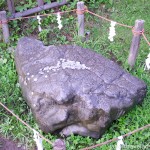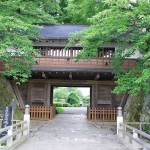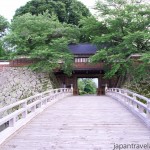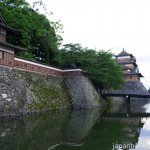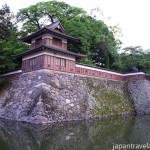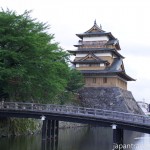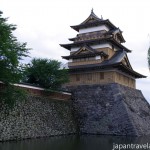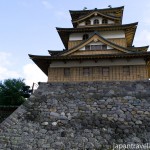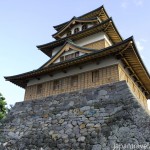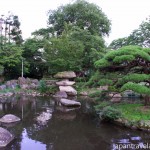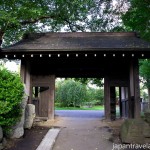
Takashima Castle in Suwa, Nagano Prefecture
Takashima Castle on the shores of Lake Suwa in Nagano Prefecture is one of the most beautiful castles in Japan. The original castle was built in 1598 on a small island on Lake Suwa (Suwa-ko). The castle was known as “The Floating Castle of Suwa” as it appeared to be floating on top of the lake. It was considered an impregnable water fortress. The castle is famous for being the highest elevated flatland castle ever constructed in Japan.
Most of the original structures were torn down during the Meiji Restoration with the stone walls the only original part remaining. A large restoration process took place in 1970 with the castle keep, kabuki gate and sumi yagura (corner turret) all being fully restored. The area that was the main bailey (honmaru) has been turned into a beautiful public park.
An Overview of Takashima Castle
The main enclosures of the honmaru, ninomaru and sannomaru were arranged in a direct line, which was typical of hilltop castles of the era. The entire fortress was a water castle being surrounded by Lake Suwa and several rivers.
The Honmaru was the main bailey and contained the three-story castle keep. The daimyo (feudal lord) residence and administrative offices were also contained within the honmaru.
The Ninomaru or second bailey contained a residence for the chief retainer as well as staff workroom, rice storeroom, treasury and stables.
The Sannomaru or third bailey contained more residences and offices for staff members.
What to See at Takashima Castle
The Main Castle Keep ~ Donjon
The three-story castle keep (donjon) is located within the honmaru and is approximately 20 meters high. The modern structure is a concrete reconstruction that was built in 1970. I quite like its interesting light-brown colour which is very different from most other castles in Japan. The view from the top of the main keep is spectacular, and on a clear day you can see the iconic Mount Fuji.

The Kabuki-mon Gate
The Kabuki-mon Gate guarded the main entrance to the honmaru and is reached by crossing the main bridge over the moat. The gate is very beautiful in its simplicity and basically consists of two front vertical pillars with one horizontal cross beam.

The Corner Turret ~ Sumi Yagura
The Corner Turret or Sumi Yagura is located at a strategic point of the castle’s defenses. The turret provided a wide field of view as well as being used as a storehouse for weapons, food and supplies.

The Kameishi Stone
The Kameishi Stone is located in the garden of Takashima Park. The stone has a legend attached to it that says if you put water on the stone your wish will come true. Apparently when you put water on the stone it has the appearance of a turtle (kame in Japanese). This turtle will grant your wish.

The Honmaru ~ Takashima Park
The area that was the former honmaru of the castle has been turned into a beautiful park. The park first opened to the public in 1876. It is a great spot to see the cherry blossoms in spring as well as the wisteria in May. The cherry blossoms usually reach full bloom in mid-April.

History of Takashima Castle
Construction of Takashima Castle began in 1592 by Hineno Takayoshi, a samurai warrior, and member of the clan of Japan’s then ruling lord, Toyotomi Hideyoshi. Takayoshi was appointed the daimyo (feudal lord) of the Suwa Domain, which was also called the Takashima Domain. Takayoshi was an expert castle builder and within a year of his transfer to the area he had surveyed the land and completed his designs for a castle. Takashima Castle was completed in 1598 and served as the center of the Suwa Domain. At that time the waters of Lake Suwa reached the edges of the castle, making it seem like it was floating on top of the lake. For this reason, the castle was known as “The Floating Castle of Suwa”. The other sides of the castle were protected by several rivers which formed a natural moat and the castle was regarded as being an impregnable water citadel.
After the victory of Tokugawa Ieyasu at the Battle of Sekigahara in 1600, the Suwa Domain was returned to its former ruler the Suwa Clan and Suwa Yorimizu in 1601. The Suwa Clan ruled over the Suwa Domain and Takashima Castle for the next 270 years until the Meiji Restoration.
In 1871, a decision was made to dismantle the castle (a symbol of the old feudal system) by the Meiji Government. The castle keep was torn down in 1875 and the main bailey (honmaru) was turned into Takashima Park and opened to the public. In 1970 many parts of the castle were restored including the castle keep, the kabuki gate, and the corner turret (sumi-yagura). Some of the original stone walls remain.

Opening Hours
Takashima Castle is open from 9:00 am to 5:30 pm (to 4:30 pm from Oct 1 to March 31)
Closed the 2nd Thursday in November and from December 26-31
Entry Fee
Admission to the castle is 300 yen for adults and 150 yen for children
How to Get There
Take the JR Chuo line to Kamisuwa Station. The castle is a short walk of about 10 minutes from the Suwa-ko Exit of the station.
Parking is also available if you come via car. The castle is approximately 15 minutes from the Suwa Exit on the Chuo Expressway.
Address: 1-20-1 Takashima, Suwa-shi, Nagano-ken 392-0022
Best Time to Go
The best time to visit Takashima Castle is in spring for the beautiful cherry blossoms, which surround Takashima Park and the castle. Winter is also spectacular with the frozen moat.
Tip: Make sure you also visit nearby Matsumoto Castle, which is one of the few remaining original castles in Japan, and truly magnificent. .
